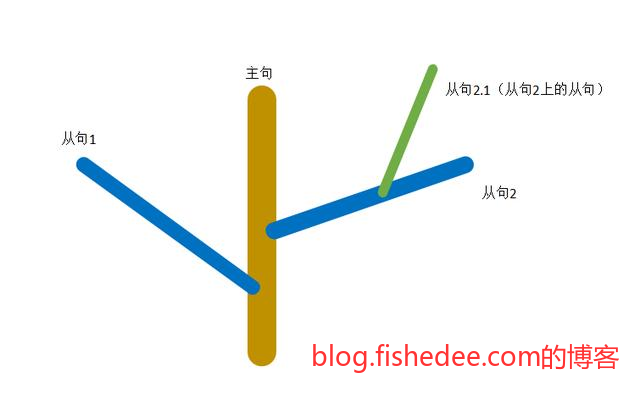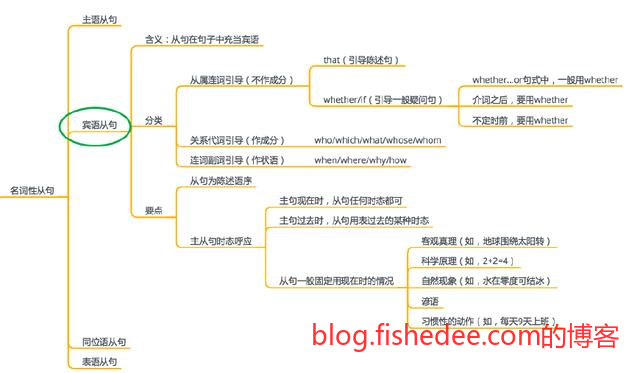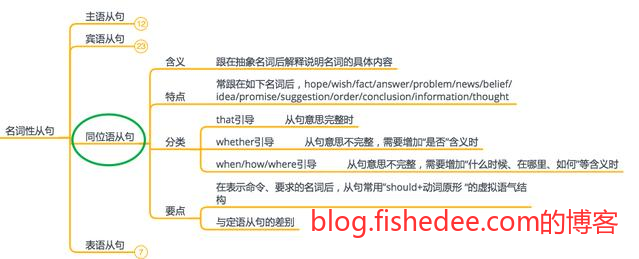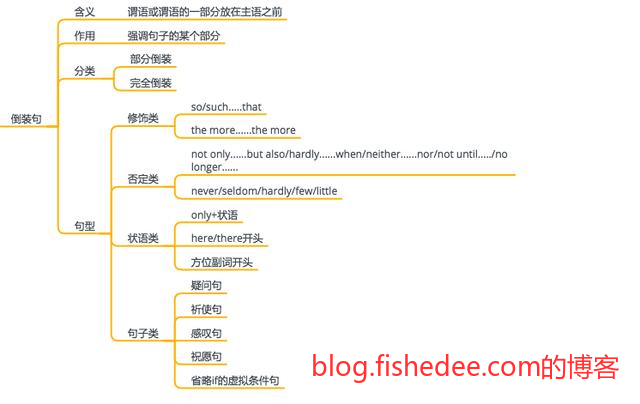0 概述
句子成分,句型和从句是英语语法中最核心的一个模块。
英语的句子按其结构可分为三种,简单句、并列句、复合句。
1 简单句
1.1 主+谓
一个句子是为了说明一件事(或表达一种感情)
- I dance.
- She died.
- we agree.
1.2 主语+谓语+宾语
句型2在句型1的基础上多了一个宾语,宾语是什么呢?还是从句子表达事情的角度看,可以理解为“谁,对谁怎么样了”。宾语,就是主语借助一个动作(谓语)作用的一个对象。
- I hate him.
- I love you.
- I dance with her. (dance是不及物动词,所以加了介词才能接名词)
1.3 主语+谓语+间接宾语+直接宾语
在这个句型里,我们发现谓语后面跟了两个宾语,直接宾语,就是谓语动词直接作用的对象,而间接宾语,是指谓语需要先借助于一个间接的对象,再把动作传递到直接宾语身上。
- I give him a book.(“给”,这个动作,最终作用的对象是“书”,但需要先通过“他”,把“给”这个动作传递到书)
这种句型较少
1.4 主语+谓语+宾语+宾语补足语
相对于句型2,这种句型中又多了一个宾语补足语,“补足”意思就是补充说明,所以宾语补足语的作用,就是用来补充说明宾语怎么样了。
- I want you to go with me.(我要你,要你干什么呢?to go with me,即要你跟我一些走,这个部分就是宾语补足语。)
1.5 主语+系动词+表语
表语,就是跟在系动词后面的成分的一个统称,不用过分在意它是什么意思。感官类系动词,其后一般接形容词;be动词后一般接名词(或不定式等)。注意是,系动词,不是及物动词。
- It smells good.
- She is a teacher.
2 从句
从句,就是在简单句的基础上,添加了一些附属的成分后所构成的复合句式,这些附属成分是以句子的形式存在的。也就是说,简单句里面再套了一个句子,这种嵌套关系是通过关联词来连接的。
- I like the girl.
- The girl is standing under the tree.
可以组合为:
- I like the girl who is standing under the tree.
2.1 名词性从句
名词性从句,分为主语从句、表语从句、宾语从句、同位语从句四类。什么叫名词性从句呢?就是从句在整个句子中作名词性成分,所以统称为名词性从句。
2.2 定语从句
定语从句,大家可以对应地把它理解为形容词性从句,从句在整个句子中作形容词性成分。
2.3 状语从句
状语从句,大家可以对应地把它理解为副词性从句,从句在整个句子中作副词性成分。状语从句,是丰富句子内容的一种表达方式,它很灵活,涉及到的连词、句式用法也很多,也需要重点掌握。
3 名词性从句
名词性从句包含主语从句、表语从句、宾语从句和同位语从句。
3.1 宾语从句
宾语从句,就是在从句里面做宾语成分的句子
- I know sth.(sth在句子里作宾语,即主+谓+宾这种句式)
- she likes me.
合并一下就是
- I know that she likes me.
3.3.1 分类
从属连词引导(不作成分)
- that,引导陈述句
- whether/if,引导一般疑问句,whether…or句式中,一般用whether。介词之后,要用whether。不定时前,要用whether
关系代词引导(作成分)
who/which/what/whose/whom
- she knows what he wants.(这是一个宾语从句,同时what在从句也是作了一个宾语的成分)
连词副词引导(作状语)
when/where/why/how
- I don’t know when the bus will come。(这是一个宾语从句,同时when这个连接副词在从句中作了一个状语成分)
3.3.2 要点
从句为陈述语序
主从句时态呼应
- 主句现在时,从句任何时态都可以
- 主句过去时,从句用表过去的某种时态
- 从句一般固定用现在时的情况。客观真理(如,地球围绕太阳转)。科学真理(如,2+2=4)。自然现象(如,水在零度可结冰)。谚语。习惯性的动作(如,每天9点上班)
3.2 主语从句
主语,我们之前讲过,指一个句子要说明的对象,是句子的主体。主语从句,就是指可以用来做句子主语的一种从句。
- she likes me.
- It makes me happy.(It 是句子的主语)
合并后,变为
- That she likes me makes me happy.
3.2.1 分类
分类:
- 连词,that/whether引导,不作成分
- 关系代词,what/who/which引导,作成分
- 连接副词,how/when/why/where引导,作成分
3.2.2 要点
It 作形式主语
常见句型
- It + be + 名词 + that从句。(It is a fact that…)
- It + be + 形容词 + that从句。(It is necessary that …)
- It + 不及物动词 + that从句。(It appears that …)
- It + be + v-ed + that从句。(It is said that…)
因为外国人习惯让主语、谓语等主要成分保持简洁,不喜欢拿一个很长的句子作主语。但当主语就是很长怎么办呢?这个时候,他们会用It这样一个简单的词来充当主语,而把it指代的一个句子放在后面,让句子看起来更清爽。例如:
- 正常的主语从句:That she likes me makes me happy.
- 修改之后的主语从句:It makes me happy that she likes me.
3.2.3 形式主语+不定式/动名词
看这里
错误,It is no use for you coming here。动名词的逻辑主语,不能用for的形式
正确,It is no use your/you coming here。动名词的逻辑主语,只能用人称代词的宾格或者所有格。
正确,It is hard for us to leave the shcool。不定式的逻辑主语,可以用for sb的方式
正确,It is kind of him to help us。不定式的逻辑主语,可以用of sb的方式
当表示人的特质,人格性的词时候,用of,这里kind 就是表示人的一种性格。像wise,foolish,nice,等 也是用of。如果不表示人物的特质性格的时候用for.
3.3 表语从句
它跟在系动词后面,用来说明主语是什么或主语怎么样了。
系动词的分类有(词法上有介绍过的):
- 状态类(说明主语性质):be(am/is/are)
- 持续类(说明主语保持的状态):keep/rest/remain/stay
- 变化类(说明主语变成什么样):become/grow/turn/fall
- 感官类(主语用感觉器官感受):smell/sound/taste/feel
- 表象类(说明主语像什么):seem/look/appear
例如:
- It seems that she didn’t like me.
- That is why I came here.
- It looks as if he is angry.
注意到没,只要能识别出系动词,我们就知道一个从句是不是表语从句了,很简单。另外,在使用表语从句时,时态上没有特别的限制,不要求从句谓语跟系动词的状态保持一致,只要符合说话的场景即可。
3.3.1 分类
- that引导
- as/as if/though/because引导
- whether引导
- where/when/why/how引导
- what/who引导
3.3.2 常用句型
- It seems that …
- The question is that …
- My opinion is that …
- The fact is that …
- That’s why …(用来说明结果)
- That’s because …(用来说明原因)
- That’s what …(用来说明原因)
- It looks as if …
3.4 同位语从句
同位语,按字面意思理解,就是具有相同地位的成分,与谁具有相同地位呢?就是同位语前面的那个名词。也就是说,同位语就是用来说明它前面的那个名词的内涵的,同位语成分翻译成中文,可用“即。。。”,“也就是。。。”这类表达方式。
同位语例子:
- He my brother is a superstar。他,即我的哥哥,是个明星。my brother 就是he的同位语,两者指同一个对象,只是同位语的含义更具体。
- We both can do it。我们,两个人,都可以做。both就是we的同位语,两者也指同一个对象。
3.4.1 特定名词后面
同位语从句,就是用一个句子来做同位语成分,通常跟在一些特定的名词之后。
这些名词有:
- hope
- wish
- fact
- answer
- problem
- news
- belief
- idea
- promise
- suggestion
- order
- conclusion
- information
- thought
例如:
- The fact that she didn’t like mereally hurts me.
- we are talking about the problem whether he should buy a bike.
判定同位语的方式,即,看同位语去掉后,句子的语义是否仍然完整,句子成分是否完整。如果完整,那就是同位语从句,因为同位语从句不像宾语从句、主语从句、表语从句等,它们都需要做句子成分,去掉后,句子成分就缺省了。
3.4.2 分类
分类:
- that引导,从句意思完整
- whether引导,从句意思不完整,需要增加“是否”含义
- when/how/where引导,从句意思不完整,需要增加“什么时候,在那里,如何”等含义时
3.4.3 要点
- 在表示命令、要求的名词后,从句常用”should+动词原形”的虚拟语气结构
- 注意与定语从句的区别
3.4.4 同位语与定语
同位语只能由名词、代词、动名词以及从句来充当,不定式和现在分词属于非谓语动词,本质上还是动词,所以不能作同位语。
- He’s getting a job tonight driving a truck. 这句中是driving a tuck是job的定语;
- Soon came the order to start the general. 这句中是to start the general是order的定语。
4 定语从句
今天我们来讲形容词性从句,即定语从句。为什么定语从句叫形容词性从句呢?因为定语就是修饰名词或者代词的一类成分,它跟形容词的作用类似。
- She is a girl
- She is a beautiful girl.
合并后就是
- She is a girl who is beautiful
合并的方式是这样的,连接词跟在名词或者代词后面,然后根据连接词在从句起到的成分,从句进行排列。以上例子,who在从句是主语成分,所以,是who is beautiful,而不是who beautiful is
例如:
- Where is the book
- I read the book yesterday
合并后为:
- Where is the book that I read yesterday
合并方式类似,that指的是book,在从句中起到宾语成分,所以是that I read,而不是that read I。
要点:
- 定语从句是修饰它前面的名词的,这对理解长难句非常有帮助。
- 学会区分,定语从句的关系词,哪些指人,哪些指物,哪些又是指时间、地点、原因等状语
4.1 分类
4.1.1 指人
可以用he/she的地方就用who,可以用him/her的地方就用whom
who/whom
that,连接词在从句作宾语时可省略。例如:
- where is the book that I read yesterday,that在从句起宾语作用,所以可以省略。where is the book I read yesterday。
- She is a girl that is beautiful,that在从句起主语成分,所以不能省略。不能写为She is a girl is beautiful
4.1.2 指物
which
that,连接词在从句作宾语时可省略。
4.1.3 指地点、原因、时间等状语
分类包括:
- 指时间,when,相当于during/on/in…which
- 指原因,why,相当于for which
- 指地点,where,相当于in/at/on…which
指地点例子:
- We want to go to the park.
- Many women are dancing in the park.
合并为
- We want to go to the park where Many women are dancing。连接词在从句中起状语作用,表达地方,修饰dancing动词。在主句中起定语作用,修饰park名词。
- We want to go to the park in which Many women are dancing。我们除了可以用where,还可以用in which,这个时候的in是指从句中做状语的in,不是主句做状语的in。
指原因例子:
- I still remember the day
- I came to school on that day.
合并为:
- I still remember the day when I came to school.连接词在从句中起状语作用,表达时间,修饰came动词。在主句中起定语作用,修饰day名词
- I still remember the day on which I came to school.我们除了可以用when,还可以用on which,这个时候的on是指从句中做状语的on,不是主句做状语的on。
指原因例子:
- The reason is unknown.
- He was late for that reason.
合并为:
- The reason why he was late is unknown。连接词在从句中起状语作用,表达原因,修饰be动词。在主句中起定语作用,修饰reason名词
- The reason for which he was late is unknown。我们除了可以用why,还可以用for which,这个时候的for是指从句中做状语的for,不是主句做状语的for。
4.2 区别,同位语从句
区别:
- 同位语从句,连接词前面也是名词,但是连接词在从句中没有成分。
- 定语从句,连接词前面也是名词,但是连接词在从句中担当成分。
例如:
- The news that he will go abroad is true。he will go abroad本身就是完整的句子,that连接词在从句中不担当任何成分,所以这个句子是同位语从句。
- The idea that he told me is wonderful。he told me本身不是完整的句子,tell是及物动词的时候,接的是双宾语结构,所以,he told me本身并不完整。that连接词在从句中担当宾语成分,所以这个句子是定语从句。
4.3 区别,非限制性定语从句
非限制性定语从句,特点是:
- 从句有逗号分割开,
- 修饰对象,除了修饰连接词前面的名词外,还修饰整个句子
- 连接词,绝对不能用that,可以用who/whom,which,why,where和when
例如:
- My sister, who is a teacher, always encourages me to study hard。who is a teacher,这个从句就是有逗号分割开的,它的意思是修饰my sister,同时也在修饰整个句子。翻译的时候,不是 “我那当老师的姐姐总是XXX”,而是“我的姐姐,她是个老师,总是XXX”
- My sister always hits me, which makes me unhappy。这个从句就是有逗号分隔开的,它修饰的明显是一整个句子,而不是me。
4.4 区别,名词性从句
定语从句的连接词,有that,which,who/whom,where,why,when。定语从句去掉以后,主句不缺乏成分。
名词性从句的连接词,有what,how,whether。名词性从句去掉以后,主句子缺成分。
4.4 特定情况只能用that
定语从句修饰的词(即,先行词),前面有形容词最高级时
- This is the best film that I have seen. (先行词是film,前面有the best修饰它,这时候只能用that,强调“最好的”)
先行词被the very/the only/the same/the last等修饰时
- She is the only girl who has got a prize.(先行词是girl,前面有the only修饰它,这时候只能用that,强调“唯一一个”)
先行词被序数词修饰时
- The first place that they visited was the Big Ben.(先行词是place,前面有the first修饰它,这时候只能用that,强调“第一个”)
先行词正好是anything/everything/nothing/few/all/none/little/some等词时
- All that can be done has been done.(先行词是all,这时候只能用that,强调“所有的”)
- There is little that I can do for you.(先行词是little,这时候只能用that,强调“没有、很少“)
先行词前面有who,which等疑问代词时
- Who is the man that is standing there?(先行词是man,但前面有疑问词who,这时候只能用that。我们可以认为,这是英语中为了避免重复而做出的限定。英语表达的一个特征就是不喜欢重复,所以,在一个场景下, 表达相同含义时,通常会用很多同义词或近义词)
先行词既有人,也有物时
- The writer and his work that you told me are really famous.(先行词有writer和work,一个是人,一个是物,为了统一,这时候我们不能用who或which,只能用that)
4.5 紧缩to do的定语从句
参看这里
4.5.1 介词+关系代词+不定式
当引导定语从句的关系代词用作介词的宾语时,有时可用”介词+关系代词+不定式”这样的结构来简化定语从句。通常表现形式:in which to do sth,with which to do sth,on which to do sth.
She must have time in which she can grow calm.
She must have time in which to grow calm
Allow me one minute in which I can change my clothes.
Allow me one minute in which to change my clothes.
可以看到,紧缩的时候,其实是将前面的主语 + can do sth省略为to do sth了
- He was miserable unless he had neighbors with whom he could quarrel
- He was miserable unless he had neighbors with whom to quarrel
whom代表的是he could quarrel with sb.的宾语
- She had some money in the bank,with which she could help her mother
- She had some money in the bank,with which to help her mother。
注意,这个定语从句是,非限制性定语从句,which描述的是She had xxx的这个事,而with,是help sb. with sth.的介词
4.5.2 介词+不定式
在部分情况下,我们可以进一步省略关系代词,只保留介词和不定式。注意,这时候介词要移至不定式之后,且当先行词为表时间的名词时,该介词通常省略。
She must have time in which she can grow calm.
She must have time in which to grow calm
She must have time to grow calme (in)
Allow me one minute in which I can change my clothes.
Allow me one minute in which to change my clothes.
Allow me one minute to change my clothes (in)
又例如:
- He was miserable unless he had neighbors with whom he could quarrel
- He was miserable unless he had neighbors with whom to quarrel
- He was miserable unless he had neighbors to quarrel with
定语从句的先行词,不是表时间的,所以,末尾的with介词不能省略
4.5.3 误区,关系代词+不定式+介词
关系代词+不定式+介词,这种句型是错的。
- 要么是,介词+关系代词+不定式
- 要么是,省略关系代词,不定式+介词
例如:
- 正确,There the children had a garden in which to play
- 正确,There the children had a garden in which they could play
- 正确,There the children had a garden to play in
- 错误,There the children had a garden which to play in
5 状语从句
状语其实更好理解,它是典型的枝干,是帮助句子完善细节的一个成分。完善的细节,可以包括,时间、地点、原因、方式、目的、结果、条件等。例如,on that day,in the desk,by bike。
总体而言,状语修饰的是动词,形容词,副词,全句。例如:
- He is sad to hear the bad news,to hear the bad news修饰形容词
- The food is very delicious,very就是修饰形容词
- The student usually have lunch in the school,usually修饰动词
- He works very hard on his subject,hard是副词,修饰work动词,同时,very是修饰hard副词,它也是个状语。
- 从句,My friends dislike me because I’m handsome and successful.(修饰全句)
5.1 表时间的
- when/while/as,when中的谓语动词可以是延续性或瞬时的,while中的谓语动词必须是延续性,强调同时发生,as中的谓语动词是延续性的,强调动作先后发生的
- before/after,before中的谓语动词不用否定形式,主句在前,从句在后(才,就)。after主句在后,从句在前。
- until/till,主句谓语是瞬时动作,必须用否定形式;(直到。。。才。。。)主句谓语是延续性动作,都可以;(在。。。之前一直。。。)
- since,主句完成时,从句过去式
- as soon as/the moment/the minute
- hardly… when,要倒装
- each time/every time
5.2 表地点的
- when…,there…
- anywhere/wherever
5.3 表原因的
- because/since/as/for
5.4 表目的
- so that/in order that
- in case/for fear that
5.5 表结果的
- so … that,接形容词或副词
- such … that,接名词
5.6 表方式的
as/as if/as though,从句虚拟语气
5.7 表让步的
though/although,不能和but连用
5.8 表比较的
- as … as
- than
- no more than
5.9 表条件的
- if/unless
- on condition that/so long as/in case
- supposing that/providing that
- only if/if only,只要。。。要是。。。
5.10 例子
When Chou En-lai’s door opened, they saw a man of more than average height with gleaming eyes and a face so striking that it bordered on the beautiful.
- When Chou En-lai’s door opened,时间状语从句,修饰整句
- so … that 是状语从句,修饰形容词striking
- of more than average height,是定语,修饰man,介词短语的形式修饰
6 there be
6.1 要点
- there is a book.
there是引导词,be是谓语动词,a book是名词,更是主语。可以看出,这个句型中,主谓倒置了
- there is a book
- there are three books
be动词是用is还是用are,取决于后面的名词是单数还是复数
- There is a book。表示某地或某时间有什么东西,东西是客观存在的,独立的事物
- I have a book。表示主语拥有什么东西,东西是从属于主语的。
6.2 常用句型
常用句型有:
- there is/are sth。(有…)
- there is not sth。(没有…)
- there is nothing to do。(没什么可做)
- there is no use doing。(做…没有用)
- there is no need to do。(做…没必要)
- there is no point in doing。(做…没意义)
- there is said to be。(据说…)
- there must be。(一定有…)
6.3 非谓语形式
- there being
- there to be
7 倒装句
一个正常的句子,形式是“主语+谓语+其他”,主语在谓语之前。而倒装句,其实就是把谓语(或谓语的一部分)放在了主语之前形成的句式。例如:
- Here comes the bus。(come是谓语提前了)
- Are you hungry?(be动词提前了)
- May I come in?( may 是情态动词,提前了)
7.1 分类
我们可以把倒装句分为两类。一类叫完全倒装句(谓语在主语前),一类叫部分倒装句(情态动词或助词在主语前)。
部分倒装:(标红的为提前的助动词或情态动词)
- Never have I watched such a moving film.
- No sooner had she seen him than she smiled
- May you be happy forever.
完全倒装:(标红的为提前的谓语)
倒装的意义在于,渲染氛围,强调意图
7.2 常用句型
7.2.1 强调否定含义
no longer…;no more…等否定意义的短语。
- No longer was he in this school. (强调他已经不在了)
not until…
- Not until I began to study did I realize how much time I had wasted.(强调我此前一直没学习,直到……)
never、seldom、hardly、little、few 等否定含义的词位于句首。
- Never shall I forget her. (强调我绝不会……)
- Seldom did I go to that park.(强调我很少……)
neither……nor;no sooner……than;not only……but also;hardly……when等词组。
- Neither do I know it, nor do I care about it. (强调我既不……,也不……)。
- Hardly had he arrived when the rain left. (强调他此前一直没来,直到……)
Not only will we go there, but also all my friends will come with us. (这个句型不算否定,但形式跟其他几种否定类似,就一起放在这里,这是一个肯定含义的词组哦)
7.2.2 强调状语
Only + 状语 位于句首
- Only in this way can we solve the problem. (强调只有用这种方法,才能……)
here/there/then 位于句首
- Here comes the bus. (强调这里来了)
away/down/up/in/off等方位副词位于句首
- Away went the children. (强调走开了)
7.2.3 强调修饰
so/such……that (如此……以致……)
- So beautiful is she that everyone likes her. (强调beautiful)
the more……the more…… (越……越……)
- The more you learn, the easier it becomes.(强调easier)
倒装句,一般是把谓语或谓语的一部分提到主语前,或者把be动词这类系动词提到主语前。但以上这两种句型,虽然也存在倒装,但都是把表语(或宾语)提前了,比较灵活一点。
7.3 句子类
最后,还有一些特殊句型本质也是倒装句,比如
- 一般疑问句
- 祈使句
- 感叹句
- 祝愿句
- if引导的虚拟条件句
8 插入语
看这里
https://baijiahao.baidu.com/s?id=1629234427842498414&wfr=spider&for=pc
https://zhidao.baidu.com/question/374544990277945444.html
https://wenku.baidu.com/view/b1260843f38583d049649b6648d7c1c708a10b35.html
插入语是插在句子中的一个词,短语或者从句,通常被逗号、破折号或句子的其他部分分隔开,它与句子的其他部分之间没有语法上的关系。插入语在句中通常是对一句话的一些附加解释,说明或总结;
8.1 形容词或者形容词短语
worst still,sure enough,strange,most important of all等等。
- Strang,there is nobody in the classroom.
- 很奇怪,教师里没有人。
8.2 副词或者副词短语
personally, honestly, fortunately, luckily, for use, though, besides, exactly, surely, frankly, still otherwise等等。
- Luckily for you, I happen to have the key.
- 你很运气,我正好带了钥匙
8.3 介词短语
Of course,in shot, as a matter of fact, by the way, on the other hand, in my opinion, in conclusion等等
- In short,we should not stop halfway.
- 简言之,我们不能半途而废
- As a result, they suffered heavy losses.
- 结果,他们受到了严重损失。
8.4 现在分词短语
generally speaking, judging from/by …, talking of …, considering …等等
- Considering his age, he did very well.
- 从年龄考虑,他干得不错。
- Frankly speaking, I don’t like the job.
- 坦率地说,我不喜欢这份工作
- Talking of singing, will you go to the concert with me tonight?
- 说到唱歌,你今晚愿意和我一块去音乐会吗?
8.5 过去分词
- Painted white, we like the house better.
- 漆成白色,我们更喜欢这房子。
由于这种过去分词是独立的,没有逻辑主语
8.6 动词不定式
To be sure, To be frank, To tell you the truth, so to speak等等
- To be frank, I don’t quite agree with you.
- 坦率地说,我不太同意你的意见。
- That’s a wonderful idea, to be sure.
- 这个主意好极了,的确。
- To tell you the truth, I am not very interested in going to the show.
- 说是在的,我不太想去看演出。
8.7 代词词组
all the same,all told,all in all等等
- His crew was reduced to twenty-four all told.
- 他的船员减少到总共二十四人。
- All in all, her condition is greatly improved.
- 总的来说,她的情况有很大反转。
8.8 从句
if so/not/any,if I may say so,if you don’t mind, as you know, as you say等等
- If I may say so, we know nothing about it.
- 正如我所说的,我们对它一无所知。
- This man, as you know, is good for nothing.
- 正如你所说的,这个人是个废物
8.9 句子
I say/har , I think/hope/believe, you know/see, what’s more, that is (to say), I’m afraid, do you think/suppose等等
- It’s a great mistake, I think, not to accept their proposal.
- 我看,不接受他们的建议是个大错误
- The temple disappeared, no more remembers when.
- 谁也不记得什么时候这座庙就没有了
- The old man, it is said, was an artist but people hardly know anything about this side of his life.
- 据说,这位老人曾是个艺术家,可是人们对他这方面的生活几乎一无所知。
8.10 标点符号引导
- He was (strange as it seems) an excellent sportsman.
- 他(尽管还显得令人不解)是个出色的运动员
- He was – to me at last, if not to you – a figure that was worth having pity on.
- 至少我觉得如此,即使你不这样认为,他是一个值得同情的人。
9 总结
参考资料:
- 本文作者: fishedee
- 版权声明: 本博客所有文章均采用 CC BY-NC-SA 3.0 CN 许可协议,转载必须注明出处!




